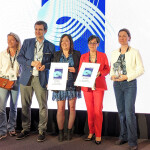Up until last week, all of the conferences I've attended combining the topics of fish farming and sustainability have turned into a forum for aquaculture bashing.
Several points in last year's Cooking for Solutions Sustainable Foods Institute made me want to get up and walk out. Misinformation about farmed fish is rampant, and at the time I didn't feel it was my place to correct panelists or attendees who harbored a huge amount of skepticism about the farmed fish industry.
"Fish farming has become a pejorative," Neil Sims, president and co-founder of Kona Blue Water Farms, said at last week's Cooking for Solutions at the Monterey Bay Aquarium in Monterey, Calif.
My blood pressure remained normal (for the most part) during this year's event. Friday's panel, Aquaculture Issues: How Do You Create Sustainable Aquaculture?, included a good balance of pros and cons related to fish farming and actually discussed some salient issues.
One critical factor in determining whether an aquaculture operation is sustainable is location, noted Sims. Kona Blue's kampachi farms in Kailua-Kona, Hawaii, are located in deep waters with a "rip snorting" current that can assimilate fish effluent, said Sims.
Nell Halse, VP of communications at Cooke Aquaculture in Blacks Harbour, New Brunswick, Canada, also discussed the importance of location with regard to the farm's effects on the environment and its sustainability plan. Cooke moves its fish to different sites on a rotating schedule, allowing sites to lay fallow.
Peter Bridson, aquaculture research manager of Monterey Bay Aquarium's Seafood Watch program, said the aquarium is gaining a better understanding of the feed issue and what changes are feasible to make farmed fish more sustainable.
"We have to be careful to look at the whole package of production systems and their real impacts," said Bridson.
The topic of feed ratios in carnivorous farmed fish was also raised by attendee Paul Johnson, founder of the Monterey Fish Market in Berkeley, Calif. Johnson quoted a 7:1 feed ratio for farmed salmon. However, Halse was quick to point out that most salmon farms have reduced the ratio dramatically, and that Cooke has reached a 1:1 feed ratio.
The panel successfully brought these and more issues to the table for discussion during the Sustainable Foods Institute. There are many examples of sustainable fish farming around the globe. We just need environmentalists to hear the accurate information, which means aquaculture companies also need to step up to the plate and stop acting so secretive.
The misinformation that has given fish farmers a black eye in the past can be changed, so we all need to take a deep breath and be respectful that things can and do change. Sometimes that change is slow, and other times it's rapid. But if there were no discussion about sustainability, there wouldn't be any change at all.
Sincerely,
Fiona Robinson
Editor in Chief
SeaFood Business
May 17, 2009





